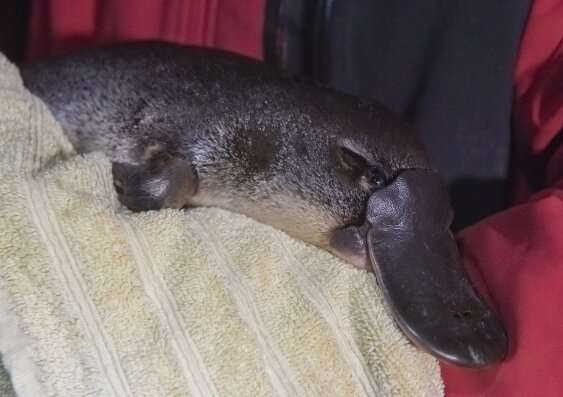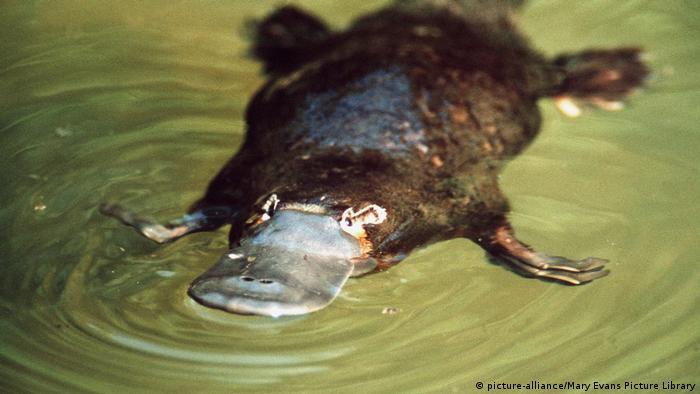by University of New South Wales

In NSW, the number of platypus observations declined by around 32 per cent in the last 30 years. Credit: Stuart Cohen
A landmark assessment by scientists at UNSW Sydney recommends the platypus be listed as a threatened species under Australia's and NSW environmental legislation.
The UNSW researchers, along with the Australian Conservation Foundation, WWF-Australia and Humane Society International Australia, today submitted their recommendations to the Commonwealth and NSW Government's scientific committees.
The International Union for Conservation of Nature (IUCN) Red List currently lists the iconic species as 'Near Threatened' – but it is not listed as threatened under Australia's Environment Protection and Biodiversity Conservation (EPBC) Act.
For their assessment, a team of researchers from the Centre for Ecosystem Science (CES) at UNSW collated all available data and evidence and assessed the species' risk of extinction against IUCN and EPBC criteria.
The scientists find that the area of eastern Australia where platypuses are found has shrunk by up to 22 percent, or about 200,000 km2, over the past 30 years.
"We recorded the most severe declines in platypus observations in NSW—particularly in the Murray-Darling Basin, where natural river systems and water flows have been the most heavily modified," says UNSW's Dr. Tahneal Hawke, a lead author of the report.
In NSW, the number of platypus observations declined by around 32 percent in the last 30 years, compared to 27 percent in Queensland. In Victoria, even though the state-wide decline was around 7 percent, the researchers observed reductions in numbers of as much as 54-65 percent in some urban catchments near Melbourne.
The scientists' models predict that platypus populations may have declined by more than 50 percent as a result of historic land clearing, river regulation, and extreme droughts—some of the major threats affecting the species. Platypuses also drown in closed freshwater yabby traps, which are still legally sold in NSW and Queensland.
"The platypus continues to face ongoing threats across its range. Unsustainable water extraction and land clearing will continue to put pressure on freshwater ecosystems and drive future declines in the future," says UNSW's Dr. Gilad Bino, a lead author.
The changing climate also presents a serious threat to platypuses, with more severe droughts, reduced rainfall and intense fires drying out rivers, reducing water quality, and destroying the riparian vegetation.
Listing the platypus as threatened would increase the scrutiny placed on developments that might endanger the species and prioritize its monitoring.
"It would also mean an increased focus on what we can do to improve the situation," Professor Kingsford, CES director, says.
The scientists say protecting one of the world's most iconic animals and the rivers it relies on must be a national priority.
"We have a national and international responsibility to look after this unique animal and the signs are not good. Platypus are declining and we need to do something about threats to the species before it is too late," Prof. Kingsford says.
Explore further Researchers warn of uncertain future for the platypus
A landmark assessment by scientists at UNSW Sydney recommends the platypus be listed as a threatened species under Australia's and NSW environmental legislation.
The UNSW researchers, along with the Australian Conservation Foundation, WWF-Australia and Humane Society International Australia, today submitted their recommendations to the Commonwealth and NSW Government's scientific committees.
The International Union for Conservation of Nature (IUCN) Red List currently lists the iconic species as 'Near Threatened' – but it is not listed as threatened under Australia's Environment Protection and Biodiversity Conservation (EPBC) Act.
For their assessment, a team of researchers from the Centre for Ecosystem Science (CES) at UNSW collated all available data and evidence and assessed the species' risk of extinction against IUCN and EPBC criteria.
The scientists find that the area of eastern Australia where platypuses are found has shrunk by up to 22 percent, or about 200,000 km2, over the past 30 years.
"We recorded the most severe declines in platypus observations in NSW—particularly in the Murray-Darling Basin, where natural river systems and water flows have been the most heavily modified," says UNSW's Dr. Tahneal Hawke, a lead author of the report.
In NSW, the number of platypus observations declined by around 32 percent in the last 30 years, compared to 27 percent in Queensland. In Victoria, even though the state-wide decline was around 7 percent, the researchers observed reductions in numbers of as much as 54-65 percent in some urban catchments near Melbourne.
The scientists' models predict that platypus populations may have declined by more than 50 percent as a result of historic land clearing, river regulation, and extreme droughts—some of the major threats affecting the species. Platypuses also drown in closed freshwater yabby traps, which are still legally sold in NSW and Queensland.
"The platypus continues to face ongoing threats across its range. Unsustainable water extraction and land clearing will continue to put pressure on freshwater ecosystems and drive future declines in the future," says UNSW's Dr. Gilad Bino, a lead author.
The changing climate also presents a serious threat to platypuses, with more severe droughts, reduced rainfall and intense fires drying out rivers, reducing water quality, and destroying the riparian vegetation.
Listing the platypus as threatened would increase the scrutiny placed on developments that might endanger the species and prioritize its monitoring.
"It would also mean an increased focus on what we can do to improve the situation," Professor Kingsford, CES director, says.
The scientists say protecting one of the world's most iconic animals and the rivers it relies on must be a national priority.
"We have a national and international responsibility to look after this unique animal and the signs are not good. Platypus are declining and we need to do something about threats to the species before it is too late," Prof. Kingsford says.
Explore further Researchers warn of uncertain future for the platypus
More information: d3n8a8pro7vhmx.cloudfront.net/ … Final.pdf?1605754019
Provided by University of New South Wales
Australia: Scientists push to list platypus as threatened
Numbers of the vulnerable duck-billed species, unique to Australia, have dropped by more than a fifth since 1990. Extreme droughts linked to climate change threaten the platypus' existence, scientists have warned.

Scientists have called for the Australian native platypus to be listed as a "threatened species" after a report found the habitat of the semi-aquatic duck-billed mammal had shrunk by up to 22% over the past 30 years.
Researchers from the University of New South Wales (UNSW) said severe drought brought by climate change, land clearing for farming and dam building are to blame.
"The platypus continues to face ongoing threats across its range. Unsustainable water extraction and land clearing will continue to put pressure on freshwater ecosystems and drive future declines in the future," lead author Gilad Bino said Monday, adding that increased severity and occurrence of bush fires is also likely to have contributed to the platypus's decline.
Droughts pose serious threat
The beaver-tailed, webbed-feet platypus live mostly across Australia's eastern coast, close to rivers and streams. They cannot live outside water. As Australia dries further, their habitat could get even smaller, the scientists warned.
Richard Kingsford, director of UNSW's Centre for Ecosystem Science, said that platypus populations "will disappear from some of our rivers without returning, if rivers keep degrading with droughts and dams."
Read more:'Wildfires are climate fires': How to talk about climate emergency, global heating
Currently, the platypus is listed as "near threatened" by the International Union for Conservation of Nature, but it is not listed as threatened under Australia's Environment Protection and Biodiversity Conservation Act.
Changing its listing would prioritize its monitoring and "also mean an increased focus on what we can do to improve the situation," Kingsford said.
VIDEO
No comments:
Post a Comment